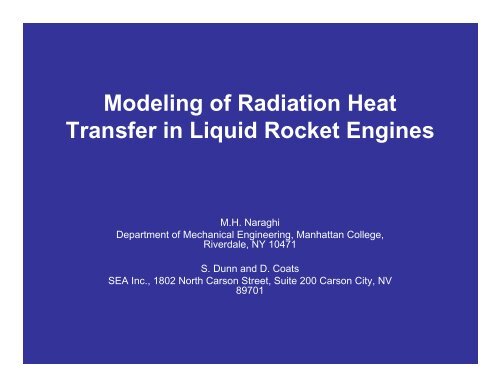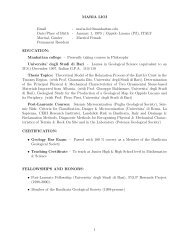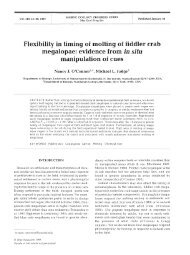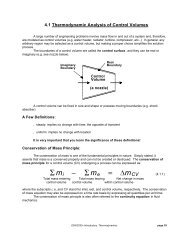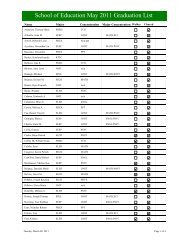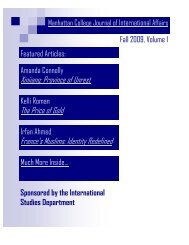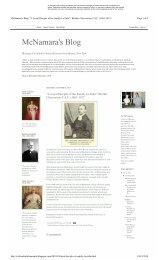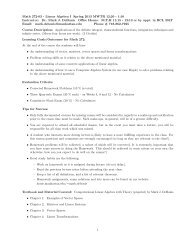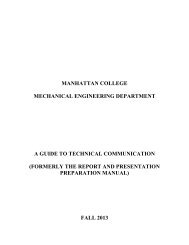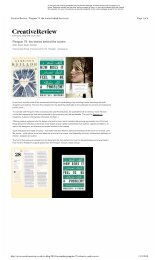Modeling of Radiation Heat Transfer in Liquid Rocket Engines
Modeling of Radiation Heat Transfer in Liquid Rocket Engines
Modeling of Radiation Heat Transfer in Liquid Rocket Engines
- No tags were found...
You also want an ePaper? Increase the reach of your titles
YUMPU automatically turns print PDFs into web optimized ePapers that Google loves.
<strong>Model<strong>in</strong>g</strong> <strong>of</strong> <strong>Radiation</strong> <strong>Heat</strong><strong>Transfer</strong> <strong>in</strong> <strong>Liquid</strong> <strong>Rocket</strong> Eng<strong>in</strong>esM.H. NaraghiDepartment <strong>of</strong> Mechanical Eng<strong>in</strong>eer<strong>in</strong>g, Manhattan College,Riverdale, NY 10471S. Dunn and D. CoatsSEA Inc., 1802 North Carson Street, Suite 200 Carson City, NV89701
Motivation• Design <strong>of</strong> cool<strong>in</strong>g circuits <strong>of</strong> regenaratively cooled rocketeng<strong>in</strong>es both a good physical <strong>in</strong>sight on the work<strong>in</strong>gs <strong>of</strong>the eng<strong>in</strong>e and a method <strong>of</strong> calculat<strong>in</strong>g the effects <strong>of</strong>design changes on the heat transfer via conjugatedconvection/conduction/radiation and cool<strong>in</strong>grequirements <strong>of</strong> LRE’s• Conjugated convection and conduction models for liquidrocket eng<strong>in</strong>es are well established (e.g., TDK-RTEmodel)• Combustion gases <strong>in</strong> liquid rocket eng<strong>in</strong>es consists <strong>of</strong>gases at very high temperatures (up to 7000R) withradiatively participat<strong>in</strong>g gases, e.g. water vapor, CO,CO 2 and soot.
Previous Works• Hammad, K.J., and Naraghi, M.H.N., “ExchangeFactor Model for Radiative <strong>Heat</strong> <strong>Transfer</strong> Analysis <strong>in</strong> <strong>Rocket</strong>Eng<strong>in</strong>es,” AIAA Journal <strong>of</strong> Thermophysics and <strong>Heat</strong> <strong>Transfer</strong>,Vol. 5, No. 3, pp. 327-334, 1991.• Liu, J., and Tiwari, S.N., “Radiative <strong>Heat</strong> <strong>Transfer</strong> Effects <strong>in</strong>Chemically React<strong>in</strong>g Nozzle Flows,” AIAA Journal <strong>of</strong>Thermophysics and <strong>Heat</strong> <strong>Transfer</strong>, Vol. 10, No. 3, 1996.• Bad<strong>in</strong>and, T. and Fransson, T.H., “Radiative <strong>Heat</strong> <strong>Transfer</strong> <strong>in</strong> FilmCooled LH/LO <strong>Rocket</strong> Eng<strong>in</strong>e Thrust Chamber”, AIAA Journal <strong>of</strong>Thermophysics and <strong>Heat</strong> <strong>Transfer</strong>, Vol. 17, No. 2, pp. 29-34, 2003.• Wang, Tee-See, “Multidimensional Unstructured-Grid <strong>Liquid</strong> <strong>Rocket</strong>Eng<strong>in</strong>e Nozzle Performance and <strong>Heat</strong> <strong>Transfer</strong> Analysis,”AIAA paper 2004-4016 presented at the 40th AIAA/ASME/SAE/ASEEJo<strong>in</strong>t Propulsion Conference and Exhibit July 11-14, 2004,Fort Lauderdale, Florida.
<strong>Radiation</strong> <strong>Heat</strong> <strong>Transfer</strong> fromHot-Gases• Combustion Gases consist <strong>of</strong> several radiativelyparticipat<strong>in</strong>g species• These species are: soot, CO, CO 2 , and watervapor• HITRAN and HITEMP database is used toevaluate absorption coefficients• Properties <strong>of</strong> the radiatively participat<strong>in</strong>g speciesare spectral, consist<strong>in</strong>g <strong>of</strong> a large number <strong>of</strong>bands• A Plank-mean approach is be used to evaluateabsorption factors
Exchange Factors betweengas and surface elementsr sirxr gidg ids ir gjr si dg j ds j ψjjijijijjjiddsrdssψτββπψψ∫−−=maxm<strong>in</strong>2)(coscos2),(rrrrrrjjijiijjjtjiddxdrrkdsgjψβ τπψψ∫−−=maxm<strong>in</strong>2)(cos2),(rrrrrrjjijijjjjiddsrdgsψτβπψψ∫−−=maxm<strong>in</strong>2)(cos2),(rrrrrrjjijijjjtjiddxdrrkdggjψτπψψ∫−−=maxm<strong>in</strong>2)(2),(rrrrrrjik tjierrr(r−−=− )τ
Radiative Nodal Po<strong>in</strong>tsNodal po<strong>in</strong>ts <strong>in</strong> axialdirection, the sameas stationsNodal po<strong>in</strong>ts <strong>in</strong>radial direction
Total Exchange FactorsAccount for wall reflection and gas scatter<strong>in</strong>gDSS[ { [ ] } ]−1−1I − dss + dsgωW I − dggωW dgs ρW dss + dsgωW [ I − dss W ]{−1= ω dgs}α0g0g−1[ I − dggωW ] dgs I − ρW dss + dsgωW [ I − dgg W ]s[ { }] −1-1dgs αDGS = ω0gs0g0g0g0gWall heat flux at station nq2nr+ mm⋅nrr, n= ∑ ws,jDSjSnEs,j+ ∑ wg,jDGjSnEg,j−j=1j=1Es= εσT4n s nEgj=4 (1 ) 4Kt−ωl 0σTgjEs,nThis model is built <strong>in</strong> the TDK’s radiation module (RAD2005)
0.6Plank-Mean Properties for Water-Vapor0.5Ka/P (cm bar) -10.40.30.2HITEMPHITRAN0.100 500 1000 1500 2000 2500 3000T, K
Plank-Mean Properties for CO 20.40.35ka/P (cm bar) -10.30.250.20.15HITEMPHITRAN0.10.0500 500 1000 1500 2000 2500 3000T, K
Plank-Mean Properties for CO0.040.035Ka/P (cm bar) -10.030.0250.020.015HITEMPHITRAN0.010.00500 500 1000 1500 2000 2500 3000T (K)
Absorption Coefficient <strong>of</strong> SootWhen eng<strong>in</strong>es runn<strong>in</strong>g with rich hydrocarbon fuels soot is present<strong>in</strong> the combustion gases.As <strong>of</strong> today little is known about the nature <strong>of</strong> the production,Destruction, shape and size distribution. An approximate value<strong>of</strong> soot absorption coefficient can be obta<strong>in</strong>ed via:k = 3.72f C T / Ca v 0 2CWhere f v is volume fraction <strong>of</strong> soot0=( n2−k236+π2)nk2+ 4nC 2 =1.4388 cm K, n and k are real and imag<strong>in</strong>ary part <strong>of</strong> <strong>in</strong>dex <strong>of</strong>refraction2k2
Computer ModelThe properties and computational models(RAD2005) discussed were <strong>in</strong>corporated <strong>in</strong>the TDK-RTE.Naraghi, M.H.N., Dunn, S., and Coats, D., “A Model forDesign and Analysis <strong>of</strong> Regeneratively Cooled <strong>Rocket</strong>Eng<strong>in</strong>es,” AIAA paper 2005-3852, present at the Jo<strong>in</strong>tPropulsion Conference, Fort Lauderdale, July 2004.
Results for a LH2-LO2 Eng<strong>in</strong>e(SSME)The specifications <strong>of</strong> this eng<strong>in</strong>e are:Chamber pressure3027 psiaO/F 6.0Contraction ratio 3.0Expansion ratio 77.5Throat diameter10.3 <strong>in</strong>chesPropellantLH2-LO2CoolantLH2Total coolant flow rate29.06 lb/sCoolant <strong>in</strong>let temperature95RCoolant <strong>in</strong>let stagnation pressure 6452 psiaNumber <strong>of</strong> cool<strong>in</strong>g channels 430
Effects <strong>of</strong> radiation on the wallheat flux <strong>of</strong> the SSMEWall <strong>Heat</strong> Flux (Btu/<strong>in</strong> 2 s)11010090807060504030No <strong>Radiation</strong>With <strong>Radiation</strong>, HITRANWith <strong>Radiation</strong>, HITEMP20-15 -10 -5 0 5 10Axial Position (<strong>in</strong>)
Effects <strong>of</strong> radiation on the walltemperature <strong>of</strong> the SSME1600Wall Surface Temperature (R)140012001000800600No <strong>Radiation</strong>With <strong>Radiation</strong> HITRANWith <strong>Radiation</strong> HITEMP-15 -10 -5 0 5 10Axial Position (<strong>in</strong>)
Effects <strong>of</strong> radiation on the coolantstagnation temperature <strong>of</strong> the SSMECoolant Stagnation Temperature (R)700600500400300200100-15 -10 -5 0 5 10Axial Position (<strong>in</strong>)No radiationWith <strong>Radiation</strong>, HITRANWith <strong>Radiation</strong>, HITEMP
Effects <strong>of</strong> radiation on coolantstagnation pressure <strong>of</strong> SSME70006500Coolant Stagnation Pressure (psi)600055005000With <strong>Radiation</strong>, HITEMPWith <strong>Radiation</strong>, HITRANNo <strong>Radiation</strong>45004000-15 -10 -5 0 5 10Axial Position (<strong>in</strong>)
Results for a RP1-LO2 Eng<strong>in</strong>eThe specifications <strong>of</strong> this eng<strong>in</strong>e are:Chamber pressure2,000 psiO/F (mixture ratio) 1.8Contraction ratio 3.4Expansion ratio 7.20Throat diameter2.6 <strong>in</strong>chPropellantRP1-LO2CoolantLO2Total coolant flow rate32.893 lb/sCoolant <strong>in</strong>let temperature 160°RCoolant <strong>in</strong>let pressure3,000 psiNumber <strong>of</strong> cool<strong>in</strong>g channels 100Throat region channel aspect ratio 2.5
Contour <strong>of</strong> the RP1-LOX eng<strong>in</strong>e108L<strong>in</strong>er radius ( <strong>in</strong> )6420-10 -8 -6 -4 -2 0 2 4Axial location (<strong>in</strong>)
Effects <strong>of</strong> radiation on the wallheat flux <strong>of</strong> the RP1-LOX eng<strong>in</strong>e5045QW, BTU/s <strong>in</strong> 24035302520No radiationWith <strong>Radiation</strong> HITEMP151050-10 -5 0 5Axial location (<strong>in</strong>)
Effects <strong>of</strong> radiation on the walltemperature <strong>of</strong> the RP1-LOXeng<strong>in</strong>e140012001000TW (R)800600No RaditionWith Radition HITEMP400200-10 -5 0 5Axial location (<strong>in</strong>)
Effects <strong>of</strong> radiation on the coolanttemperature <strong>of</strong> the RP1-LOXeng<strong>in</strong>e450400Coolant temperature, R350300250No <strong>Radiation</strong>With Rdiation HITEMP200150-10 -5 0 5Axial location, <strong>in</strong>
Effects <strong>of</strong> radiation on the coolantstagnation pressure <strong>of</strong> the RP1-LOX3000eng<strong>in</strong>e2900Coolant stagnation pressure, psi28002700260025002400No radiationWith radiation2300-10 -5 0 5Axial location, <strong>in</strong>
Effects <strong>of</strong> radiation on the coolant Mach0.35number <strong>of</strong> the RP1-LOX eng<strong>in</strong>e0.3Coolant Mach number0.250.20.150.1No radiationWith <strong>Radiation</strong>, HITEMP0.050-10 -5 0 5Axial location, <strong>in</strong>
Conclud<strong>in</strong>g Remarks• The effects <strong>of</strong> gas and surface radiation onthe wall temperature, coolant pressure,temperature and Mach number werestudied• The results presented demonstrate thatalthough the <strong>in</strong>crease <strong>in</strong> heat flux due toradiation is small, it can have a significanteffect on the wall temperature and coolantflow characteristics
Conclud<strong>in</strong>g Remarks• For a LH2/LO2 eng<strong>in</strong>e it is shown that theradiation has a small effect on the walltemperature <strong>of</strong> the diverg<strong>in</strong>g section <strong>of</strong> thenozzle• the radiation results <strong>in</strong> a substantial <strong>in</strong>crease <strong>in</strong>the wall temperature <strong>of</strong> the thrust chamber andconverg<strong>in</strong>g section <strong>of</strong> the nozzle, such that thelocal peak temperature is the same order <strong>of</strong>magnitude as the throat temperature
Conclud<strong>in</strong>g Remarks• For the RP1/LO2 eng<strong>in</strong>e, radiative heattransfer resulted <strong>in</strong> a 30% <strong>in</strong>crease <strong>in</strong> walltemperature. Additionally, it significantly<strong>in</strong>creased the coolant pressure drop andMach number• neglect<strong>in</strong>g radiation dur<strong>in</strong>g the designphase may result <strong>in</strong> a faulty cool<strong>in</strong>gsystem
Availability <strong>of</strong> the <strong>Radiation</strong> CodeRAD2005• The model presented is <strong>in</strong>corporated <strong>in</strong> aprogram (RAD2005) which can be l<strong>in</strong>kedto TDK and RTE• TDK from S<strong>of</strong>tware Eng<strong>in</strong>eer<strong>in</strong>gAssociates, Inc. (sea<strong>in</strong>c.com)• RTE from Tara Technologies, LLC(tara-technologies.com)


